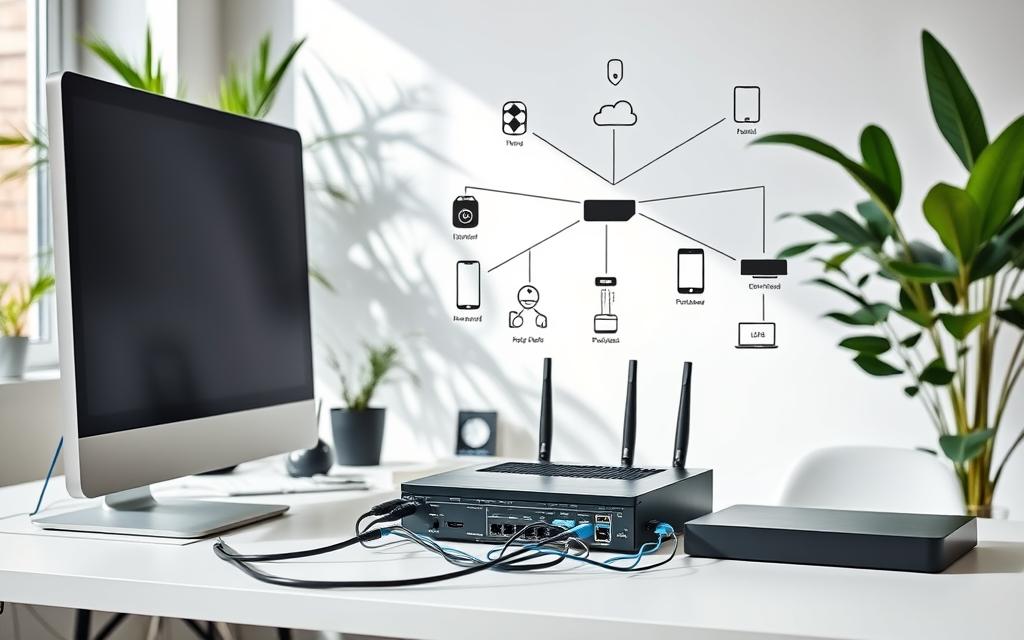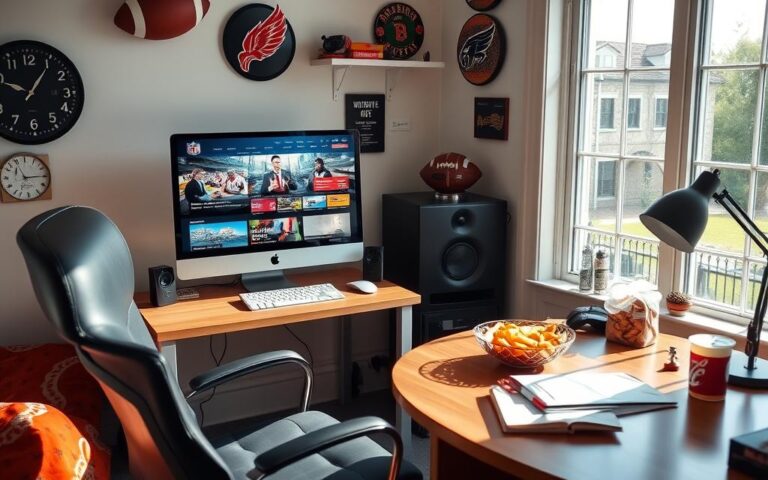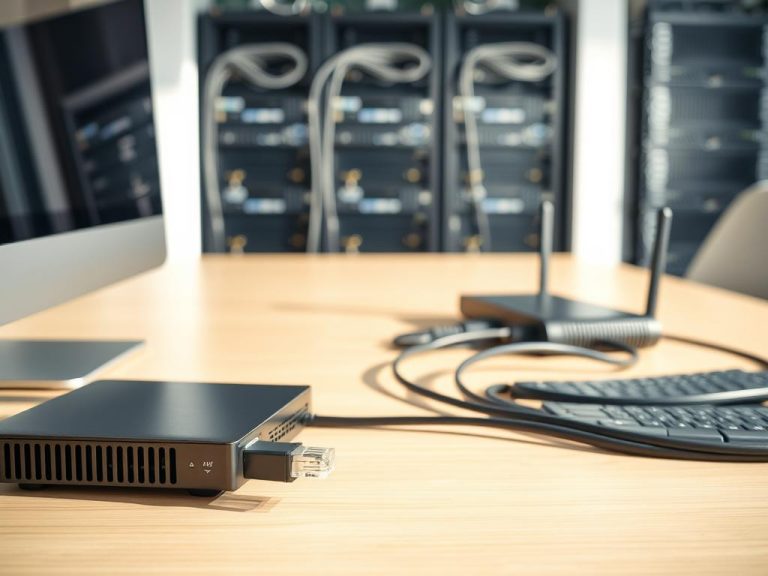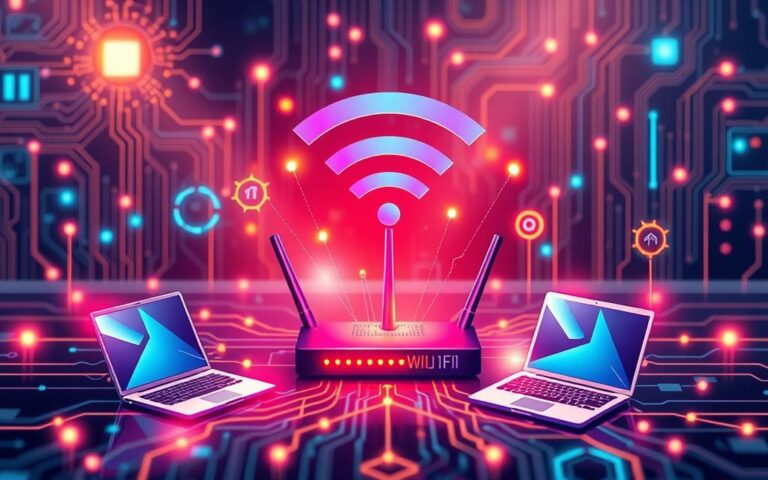Adding a New Computer to Your Network: Quick and Easy Steps
In today’s world, it’s important to connect a new computer to your network. This guide makes it easy to add another device. It gives you clear steps for a smooth connection. With more homes and businesses using broadband Internet, knowing how to set up a network is essential. Learning the basics helps you integrate devices effortlessly for a trouble-free wireless network.
Understanding the Basics of Networking
Learning about networking is key if you want a system that works well. At the start, you learn the basics, which is essential. This helps you get to know different networks and their kinds. A network links devices so they can share stuff and talk to each other. For any business, good networking makes things like working from anywhere, automating tasks, and keeping data safe possible in our online world.
What is a network?
A network ties together gadgets like computers, printers, and servers. It helps them communicate and share resources. The main point of networks is to connect things. This lets people share data and work together better, boosting an organisation’s efficiency.
Types of networks: Wired vs. Wireless
There are two main kinds of networks based on how they connect. You have wired and wireless networks. Wired networks use cables, like Ethernet, which gives you a steady and fast connection. On the other hand, wireless networks use radio signals. They offer the freedom to move around and easy setup, letting you connect from different places without cables.
| Network Type | Advantages | Disadvantages |
|---|---|---|
| Wired | – High stability and speed – Reduced interference |
– Limited mobility – Installation complexity |
| Wireless | – Greater mobility – Easy to set up |
– Susceptible to interference – Possible security vulnerabilities |
Essential Equipment for Your Network
To set up a great home network, you need the right equipment. A strong Internet connection is the base. A modem connects you to the internet, and a wireless router links all your devices together. It’s important to know how each piece helps your network work well.
Broadband Internet Connection and Modem
A good broadband connection, like DSL or cable, is key. The modem links your devices to the internet. It changes signals so your devices can use them. Now, over 90% of homes have broadband. This shows how vital a strong modem is for smooth internet use.
Wireless Router Basics
The wireless router is vital in any home network. It lets devices talk to each other without wires. It can handle data speeds up to 600 Gbps. This makes sharing data fast and convenient. Correctly setting up the router ensures your network runs smoothly. It helps avoid common speed and connection problems.
Wireless Network Adapter Importance
Some devices need a wireless network adapter to connect to Wi-Fi. This includes older laptops and some desktops. These adapters make connecting easier and more flexible. With more gadgets per person, these adapters are more important than ever. They help keep everything running smoothly. Plus, they’re easy to install, often just needing a quick check in the device manager.
| Equipment | Role | Connectivity Type | Considerations |
|---|---|---|---|
| Broadband (Modem) | Connects local devices to the internet | Wired | Ensure compatibility with ISP requirements |
| Wireless Router | Facilitates wireless communication between devices | Wireless | Check range and speed capabilities |
| Network Adapter | Connects devices to the wireless network | Wireless | Type of adapter may vary with the device |
Knowing about these parts helps you create a strong home network. This is key as we use more devices today. A good network supports all our gadgets well.
Setting Up Your Modem and Internet Connection
Having a stable Internet link is key for any network. The way you set up your modem plays a big role in your online experience. This is true whether you’re using DSL or cable. Stick to the steps given to get the best out of your modem. It’s vital to follow what the manufacturer suggests.
Connecting the Modem to Your Internet Source
Here are the first steps to take:
- Find your modem and plug it into a power source.
- Use the right cable to link the modem to your Internet. This could be a DSL line or a coaxial cable for cable modems.
- Connect an Ethernet cable from the modem to your computer or router.
Once you’ve done this, check the modem’s lights to see if the Internet is working. The right light signals will vary depending on your modem’s make and model.
Ensuring the Compatibility of Your Equipment
Make sure your modem setup is complete by checking equipment compatibility. Confirm that the modem meets your Internet service’s needs. It should also work with your router or other devices. Look at the modem specs to see:
- If it supports the speeds your Internet plan offers.
- Whether there are firmware updates to improve function and safety.
- If it has necessary features like DHCP for automatic IP addressing.
Checking equipment fit ensures better performance and a stable connection. Correctly setting up all devices helps your network run smoothly. It also helps to avoid connection problems.
Positioning Your Wireless Router for Optimal Performance
Putting your wireless router in the right spot is key for a strong signal and reliable connections. Finding the best place for it, along with tips to cut down signal interference, can greatly improve your network. This makes your online activities smoother and faster.
Finding the Best Location for Your Router
To get the best from your router, place it 1-1.5 feet off the ground. This helps strengthen the signal. It’s important to think about:
- Central Location: A central spot in the home ensures better coverage.
- Avoid Obstructions: Keep clear of walls, furniture, and appliances that block signals.
- Antenna Orientation: Antennas should be upright for one floor. Angle them at 30° for more floors.
- Avoid High-Power Appliances: Keep routers away from microwaves and cordless phones to avoid interference.
- Avoid Direct Sunlight: Sunlight can harm the router and worsen network performance.
Reducing Signal Interference
Many things at home can mess with your router’s signal. Tackling these can make your router work better:
- Minimise Walls: Keep your router where walls won’t block its signal.
- Consider Device Compatibility: Check how well the router works with different devices. This shows if placement affects performance.
- Use 5 GHz Devices: Devices on the 5 GHz band often have a stronger signal than those on 2.4 GHz.
- Install Mesh Networks: Mesh networks can expand coverage in big spaces, avoiding poor signal areas.
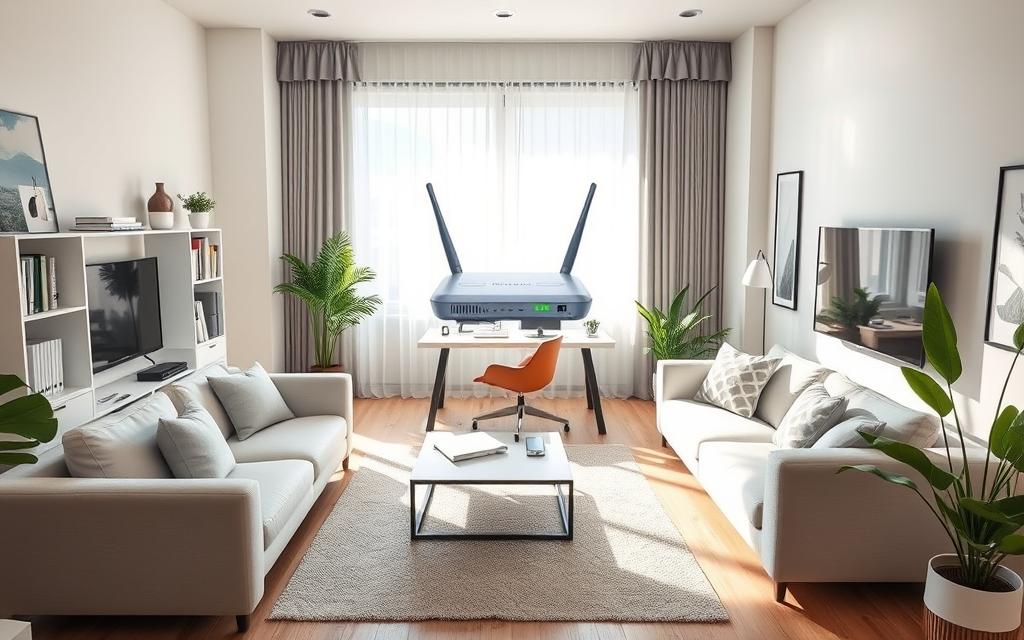
By smartly placing your router and following these interference tips, you’ll boost your network’s signal and reliability. These changes lead to a better online experience for everyone at home.
Securing Your Wireless Network
Protecting your wireless network is key in our modern digital world. Several steps can greatly improve network security, keeping devices safe and personal data secure.
Changing Default Credentials for Your Router
Changing the default router credentials is a crucial step for strong network security. Routers are often set up with common usernames and passwords that attackers know. By choosing unique, strong router credentials, you can greatly lower the risk of being hacked. It’s a good idea to use a mix of upper- and lower-case letters, numbers, and symbols.
Implementing a Network Security Key
Choosing a strong security key is another vital step. WPA3 encryption is the best method today for securing wireless connections. Even WPA2 is more secure than the outdated WEP protocol. A strong network security key encrypts your data and makes it hard for hackers nearby to access your network.
Using Firewalls to Protect Your Devices
Adding firewall protection is essential for your network’s defence. Both software and hardware firewalls help filter traffic, stopping potential risks. Keeping router firmware updated and firewalls activated increases security. Updates from manufacturers can improve safety features, which is why it’s important to keep your router updated.
By changing default credentials, using a strong security key, and applying firewall protection, you make a secure online space. This lets users connect their devices without worrying about losing personal data.
How to Add Another Computer to My Network
Adding a new computer to your network boosts productivity and sharing. Knowing how to connect through Wi-Fi or Ethernet ensures a smooth setup. We’ll look at both to make it easy.
Connecting via Wi-Fi
For most new computers, Wi-Fi is the go-to choice. Begin by opening the Wi-Fi settings on your computer. Follow these steps:
- Click on the Wi-Fi icon in the taskbar.
- Choose your network from the list.
- Enter the password, then hit ‘Connect’.
Can’t see your network? Check if your router is on and Wi-Fi is active. Restarting your router might fix connection problems.
Connecting via Ethernet Cable
Prefer a wired link? Ethernet gives you speed and dependability. Here’s the way to connect:
- Find the Ethernet port on your computer, usually on the side or back.
- Plug one end of the Ethernet cable into your computer.
- Attach the other end to a spare port on your router or modem.
Your computer will likely recognize the network right away. This choice is great for games and streaming, offering a steady link. If there’s trouble, check the cable’s connection and try another device if you can.
| Connection Type | Speed | Setup Ease | Use Case |
|---|---|---|---|
| Wi-Fi | Fastest | Simple | General browsing, streaming |
| Ethernet | High-speed | Minimal | Gaming, file sharing |
| Bluetooth | Moderate | Accessible | File transfers |
| Infrared | Moderate | Simple | Nearby devices |
Picking the right way to connect depends on your needs. Knowing each method’s benefits helps effortlessly add your new computer to the network.
Troubleshooting Common Connectivity Issues
Having trouble connecting a new computer to your network is quite normal. It’s crucial to check the network status indicators to troubleshoot efficiently. The modem and router lights offer clear clues about their state. A red light means there’s an issue, but green shows everything is running smoothly.
Verifying Network Status Indicators
Start with a simple check of your device’s status lights before you try anything complicated. Each light tells you something different:
- Power – Indicates if the device has power.
- Internet – Shows if you’re connected to your ISP; red means there’s a problem.
- Wi-Fi – Tells you if your wireless network is up and running.
Then, you might need to look at the physical parts. Make sure cables aren’t damaged or loose. Bad connections often cause network problems. Using a wired connection could be a quick solution while you figure out the main issue.
What to Do If You Can’t Connect
If you still can’t connect, there are a few steps to take. Check that your new computer’s settings match your network. This includes Wi-Fi settings, making sure the Wi-Fi switch is on, and connecting to the correct network.
Network settings can also cause issues. Look out for duplicated or static IP addresses. Managing DHCP settings can avoid these problems. If you’re using a VPN and facing issues, check your firewall settings and how you log in.
Sometimes, slow DNS lookups or high CPU use can stop you from connecting. If the internet is slow, try adjusting your router settings. Closing applications that use too much resource can also help. For more help, follow this resource.
In today’s world, issues like ISP outages and cyberattacks are common. Using network monitoring tools can reduce their impact. Services like Obkio Network Monitoring are great for keeping an eye on your network’s health and catching problems early.
| Issue | Possible Causes | Troubleshooting Steps |
|---|---|---|
| Slow Network Speed | High bandwidth consumption, failing switch ports | Check bandwidth usage, restart affected devices |
| Weak Wi-Fi Signal | Interference from devices, physical barriers | Reposition router, minimise obstructions |
| Physical Connectivity Issues | Damaged or loose cables | Inspect cables, replace faulty ones |
| Excessive CPU Usage | Resource-hungry applications, viruses | Update drivers, terminate unnecessary applications |
| Duplicate IP Addresses | Conflicts in DHCP or static IP assignment | Review DHCP settings, resolve conflicts |
Conclusion
Adding a new computer to your network means understanding key networking concepts and having the right equipment. It’s crucial to correctly install your modem and router. You should also know about wired and wireless connections, ensuring secure setups.
By using tools like Chrome Remote Desktop or Windows Remote Desktop Connection, you can boost how you work. For security, adding Two-Factor Authentication (2FA) keeps your network safe from unwelcome visitors. Always update your passwords and software to protect against risks.
By putting these tips into action, you’re not just adding a computer. You’re building a strong, flexible network. This prepares you for new tech changes. So, invest the effort now and boost your networking skills for better performance.
FAQ
What do I need to add a new computer to my network?
You’ll need a strong broadband Internet connection and a compatible modem to start. You also need a wireless router for Wi-Fi. Plus, check if your computer needs a network adapter.
How can I improve the Wi-Fi signal strength in my home?
Place your wireless router centrally, away from the floor and household items like microwaves, to boost signal. Using devices on the 5.8 GHz frequency also improves Wi-Fi strength.
What security measures should I take for my wireless network?
Change both the default usernames and passwords on your router. Create a secure network key with Wi-Fi Protected Access (WPA3). Use both software and hardware firewalls for extra safety from online dangers.
How do I connect a computer via Ethernet?
Connect one end of an Ethernet cable to your computer and the other to a router or modem. Make sure your computer is on and ready to link up.
What should I do if my new computer can’t find the network?
Ensure the wireless is on and you’ve got the right network password. Restart your modem and router. If it still won’t connect, try using an Ethernet cable for a direct link.
How can I check if my modem and router are functioning properly?
Look at the status lights on both devices. A steady green light means all is good. But, blinking or red lights suggest a problem. Your device manuals will have more details.
Is it necessary to have a firewall if I’m using a router?
Definitely. Even with a router’s built-in firewall, adding software firewalls on your devices beefs up your security against threats.
